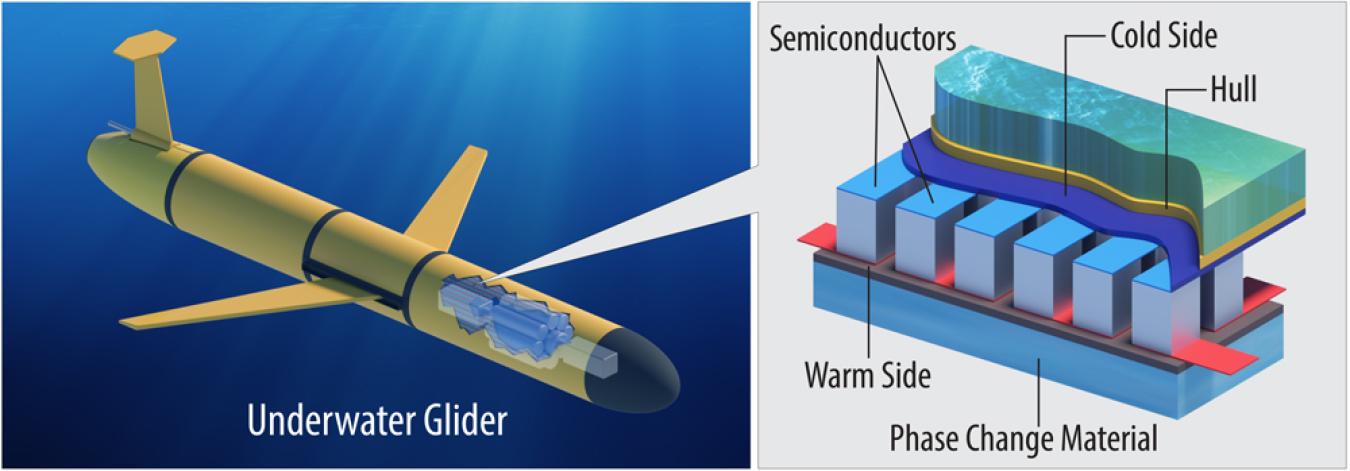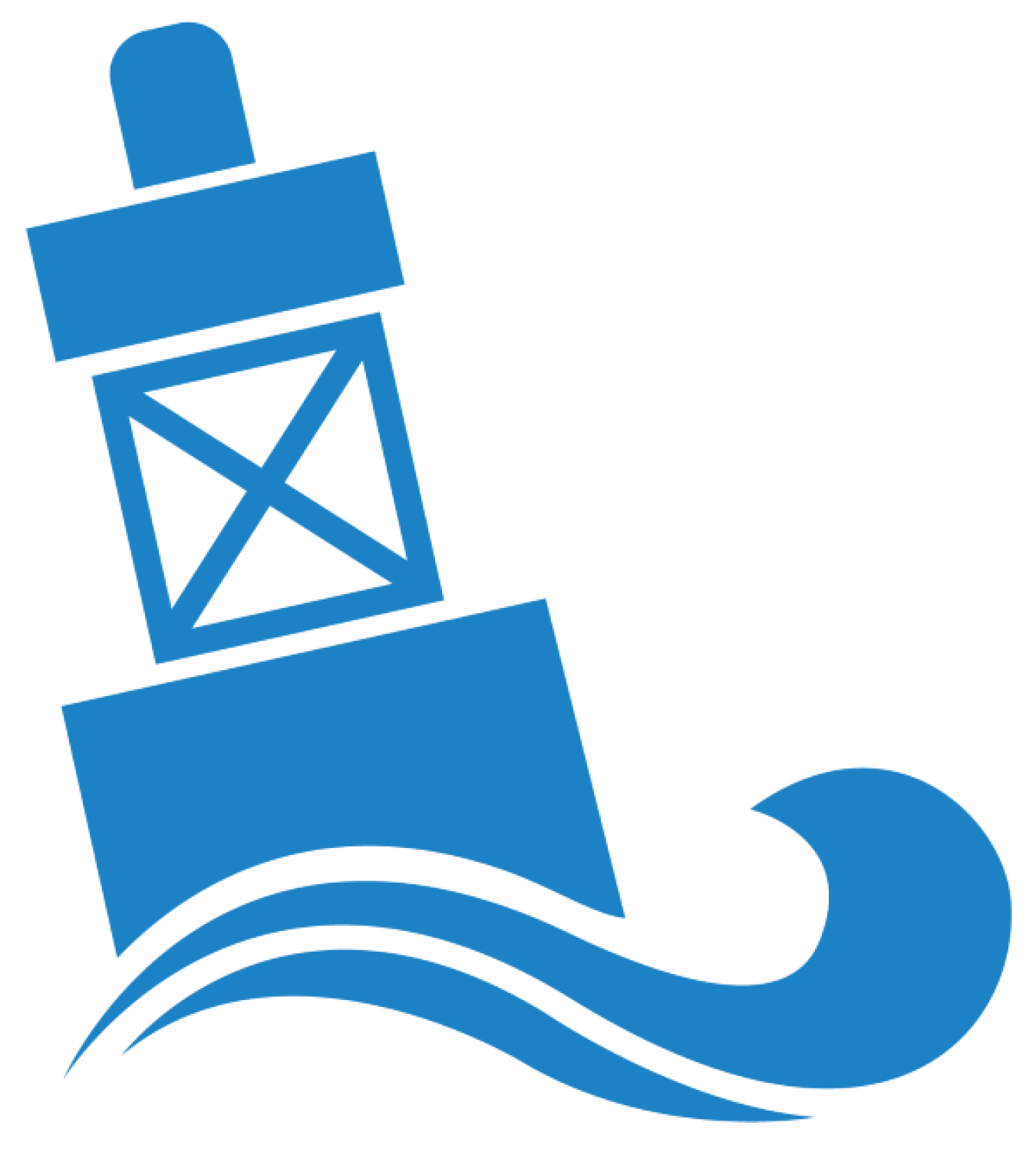NREL researchers identified optimal materials for harnessing ocean thermal gradients and generating electricity to power underwater vehicles.
Water Power Technologies Office
March 14, 2024Marine Energy Program
Technology-Specific System Design and Validation
Project Name: Harnessing Ocean Thermal Gradients Using Thermoelectric-Based Submersibles for Aquaculture and Sea Power Applications
Project Team: National Renewable Energy Laboratory
Lead Recipient Location: Golden, Colorado

In 2023, National Renewable Energy Laboratory (NREL) researchers investigated a new concept for harnessing energy from ocean thermal gradients. Their novel approach integrates materials that absorb a large amount of heat while changing from liquid to solid or solid to liquid (known as phase change materials, or PCMs) with generators that convert that heat into electricity. Together, PCMs and these generators have the potential to power uncrewed underwater vehicles and aquaculture farms.
Ocean thermal gradients are the differences in temperature between the ocean's cold, deep water and warmer surface water. Ocean thermal energy conversion (OTEC) systems use this temperature difference to produce electricity.
The use of thermoelectric generators (TEGs) with PCMs in uncrewed underwater vehicles is an unconventional OTEC system that does not require a power generation cycle (the process of compressing and heating a fluid to transform it into gas, which is used to drive a turbine). Instead, this system connects multiple TEGs that are located between hot and cold sources. The temperature source could be warm or cold ocean water. Any increase or decrease in temperature is absorbed by the PCM and harnessed by the TEGs. During the energy generation process, heat flows from the hot to the cold side of the TEGs, producing direct power. The PCM maintains the constant internal temperature of the TEGs by absorbing heat as the PCM changes from liquid to solid or from solid to liquid.

The figures show how phase change materials can be used with thermoelectric generators to power uncrewed underwater vehicles.
After performing a detailed assessment, the NREL team concluded that organic PCMs—which include paraffins, fatty acids, and polyethylene glycol, all possessing the ability to absorb and release large quantities of heat—have the required characteristics to most effectively harness energy from ocean thermal gradients. ("Organic" is one of the classifications of PCMs based on their chemical composition.) These materials can also be tailored to various geographic locations and seasons so that more energy can be harvested. Researchers also evaluated different TEGs that are commercially available, identifying five different designs that could be coupled with the recommended PCMs.
Using these results, the team recommended different combinations of PCMs and TEGs for specific seasons and locations. Their work produced optimal combinations for the North and South Atlantic, the eastern and western Gulf of Mexico, and the North, Central, and South Pacific.
Ocean thermal gradients have great potential to power uncrewed underwater vehicles in deep-water research, investigation, and exploration. They could also meet a portion of the energy requirements for aquaculture farms. By enabling self-powered uncrewed underwater vehicles, the combination of PCMs and TEGs may help devices collect more and better data. They could also be integrated with aquaculture farms to decrease carbon dioxide emissions by replacing fossil fuel consumption. This work ultimately advances the Water Power Technologies Office's Powering the Blue Economy™ initiative by providing power at sea to underwater vehicles that can better monitor the oceans.
-
 Sandia National Laboratories identified innovative wave energy converter concepts that could power sensors on an ocean observing buoy.
Sandia National Laboratories identified innovative wave energy converter concepts that could power sensors on an ocean observing buoy. -
 NREL researchers identified optimal materials for harnessing ocean thermal gradients and generating electricity to power underwater vehicles.
NREL researchers identified optimal materials for harnessing ocean thermal gradients and generating electricity to power underwater vehicles. -
Researchers at the National Renewable Energy Laboratory expanded the capabilities of their open-source modeling tool to enable simulation of marine energy turbines to help optimize technology designs.
-
 The National Renewable Energy Laboratory and Pacific Northwest National Laboratory completed the first step in developing the Community Deployment Readiness Framework to support remote, coastal, and island community-driven energy transitions.
The National Renewable Energy Laboratory and Pacific Northwest National Laboratory completed the first step in developing the Community Deployment Readiness Framework to support remote, coastal, and island community-driven energy transitions. -
ORPC tests its new Modular RivGen Power System in Millinocket, Maine. Future applications may include power for electric vehicle charging stations, critical infrastructure, and communities.
-
 Triton Systems Inc. successfully tested its wave energy converter in hurricane-level waves, proving the durability of its prototype and demonstrating that marine energy can reliably power data collection and ocean exploration activities.
Triton Systems Inc. successfully tested its wave energy converter in hurricane-level waves, proving the durability of its prototype and demonstrating that marine energy can reliably power data collection and ocean exploration activities.
WPTO's marine energy e-newsletter shares news and updates on tools, analysis, and emerging technologies to advance marine energy.
The WPTO e-newsletter brings funding opportunities, events, publications, & hydropower and marine energy updates directly to your inbox.


